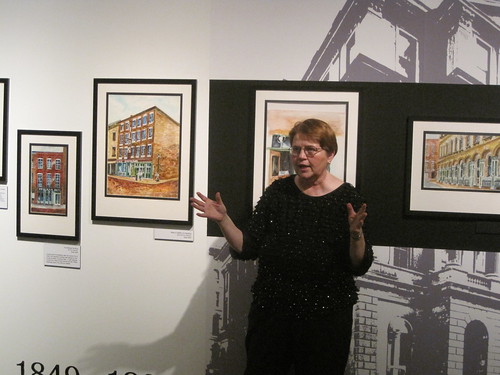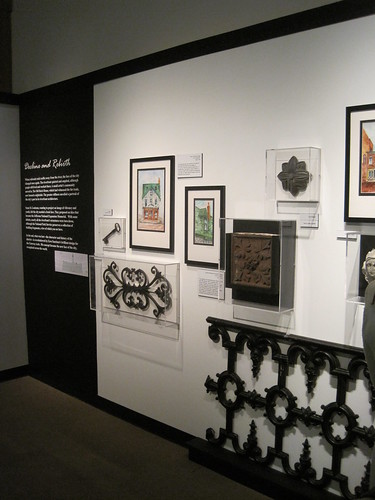The nation's only urban national park, the Jefferson National Expansion Memorial with the stunning Gateway Arch by Eero Saarinen, has long been haunted by a shadow architectural history. To make way for one of the world's most full-realized modernist landscapes, St. Louis wrecked forty blocks of historic riverfront buildings. The significance of these buildings in American architectural history was such that in 1939, eminent architectural critic and historian Siegfried Gideon came to St. Louis to deliver a lecture on the doomed buildings. Gideon not only spoke about the unparalleled mass of cast-iron facades and storefronts found on the riverfront, he implored the city to change course and preserve the riverfront's commercial buildings.
 Gideon's cry went unheeded, and plans to create a national memorial to westward expansion on the St. Louis riverfront progressed. Fortunately, the memorial's architectural achievement matched what was lost. Still, the memorial site has a psychological scar tissue to any who know what was lost there. The National Park Service has had some difficulty in interpreting the pre-memorial riverfront so that both the memorial and the prior riverfront architecture are suitably honored.
Gideon's cry went unheeded, and plans to create a national memorial to westward expansion on the St. Louis riverfront progressed. Fortunately, the memorial's architectural achievement matched what was lost. Still, the memorial site has a psychological scar tissue to any who know what was lost there. The National Park Service has had some difficulty in interpreting the pre-memorial riverfront so that both the memorial and the prior riverfront architecture are suitably honored.Thus, the current "Faces of the Riverfront" exhibit at the Old Courthouse is a welcome endeavor, and, given current events, quite timely and inspirational. (The exhibit runs through August 22, through the unveiling of designs by finalists in the current design competition.) The National Park Service gave artist Sheila Harris access to its extensive photographic record of riverfront buildings lost to build the memorial, and she painted in watercolor renderings of the documented buildings. Harris' paintings transform the hard, stoic documentation taken before the riverfront death knell into soft, humane snapshots of a still-living urban landscape.
 Sheila Harris speaks at the exhibit's opening reception on February 14th.
Sheila Harris speaks at the exhibit's opening reception on February 14th.For the next few months, visitors to the Old Courthouse will be greeted by an exhibit that properly honors the life of the riverfront, in the space once occupied by the courtroom where the Dred Scott trial unfolded. Superintendent Tom Bradley, staff historian Bob Moore and exhibits manager Caitlin McQuade deserve credit for working with Harris to create the exhibit, as does Sheila Harris's sister NiNi Harris (author of the new book Historic Photos of the Gateway Arch.)
 Alongside the paintings are rarely-seen items from the Memorial's collection of salvaged portions of riverfront buildings. Those who have seen the items on permanent display in the Old Courthouse often wonder what else remains, and here are a few answers. The expected cast iron pieces are joined by a more obscure terra cotta piece. The only problem with Faces of the Riverfront is that the fragments and watercolors pique a visitor's interest in seeing the source photographs, of which none are on display save as wall-sized backdrops. Perhaps those photographs will be made public as part of a future Memorial project.
Alongside the paintings are rarely-seen items from the Memorial's collection of salvaged portions of riverfront buildings. Those who have seen the items on permanent display in the Old Courthouse often wonder what else remains, and here are a few answers. The expected cast iron pieces are joined by a more obscure terra cotta piece. The only problem with Faces of the Riverfront is that the fragments and watercolors pique a visitor's interest in seeing the source photographs, of which none are on display save as wall-sized backdrops. Perhaps those photographs will be made public as part of a future Memorial project.





7 comments:
I could swear I once heard that NPS had warehoused cast iron facades stripped from the buildings. half-hearted research has proved fruitless.
I still maintain the position that if it had been constructed amid the old structures (see the the Pompidou Centre) the result would have been even more stunning.
I agree with you that the real photographs need to be put on display. The reality of the buildings (in the photos) will bring home the historic loss to the community. Perhaps it will underscore the importance of saving historic buildings. Unbelievable that the city would let 40 blocks of historic architecture be demolished. We don't know where we are going until we know where we have been. -- barbara
I don't know who anonymous is, but I have heard that before about the the warehouse of cast iron facades. Who knows? And I totally agree that the arch would have been amazing had it been built among (and over) the old structures.
1st anon to the other, I wish I could remember where I also heard that. I do know in recent years that's been a tactic in DC where it's referred to as "facade-in-a-box" until a developer is found to reconstruct the the base structure and attach the pieces. a Disney version of preservation IMHO, but beats a cheap curtainwall (a nicely detailed curtainwall is a different issue.
I have never liked paintings as a substitute for photographs. If the paintings were from life in that era I would be more interested, but they are not. It is truly a poor substitute for the real photographs, no matter the artists intention.
Gideon, in his book Space, Time and Architecture touted the St. Louis riverfront as some of the premier cast iron architecture in the world.
In addition to the cast iron storefronts the rock house was also supposed to be stored. Alas it is no doubt all gone to scrap dealers.
Architect Steven Holl proposed that the Arch would have been more effective rising out of the surrounding neighborhood. That proposal was after the fact in the early eighties.
He also proposed saving the historic Issac Taylor building next to the Wainwright building concurrent with the design and building of the mediocre state building that now stands next to the Wainwright Building. He was a young architect back then and nobody really cared what he thought.
He is involved in the Arch competition, it gives me some hope for a real solution.
He has an interesting website
http://www.stevenholl.com/
Yeah, I am not interested in seeing paintings of the buildings at all. I would go in a heartbeat if it were actual historical photographs, though. This seems like an odd tribute.
Even if they had put the Arch amid a field of buildings, they would never have survived the decades of obsession with clearing "views" and "green space". The same mania that claimed every building in the Gateway Mall would have killed the 40 blocks sooner or later.
Post a Comment